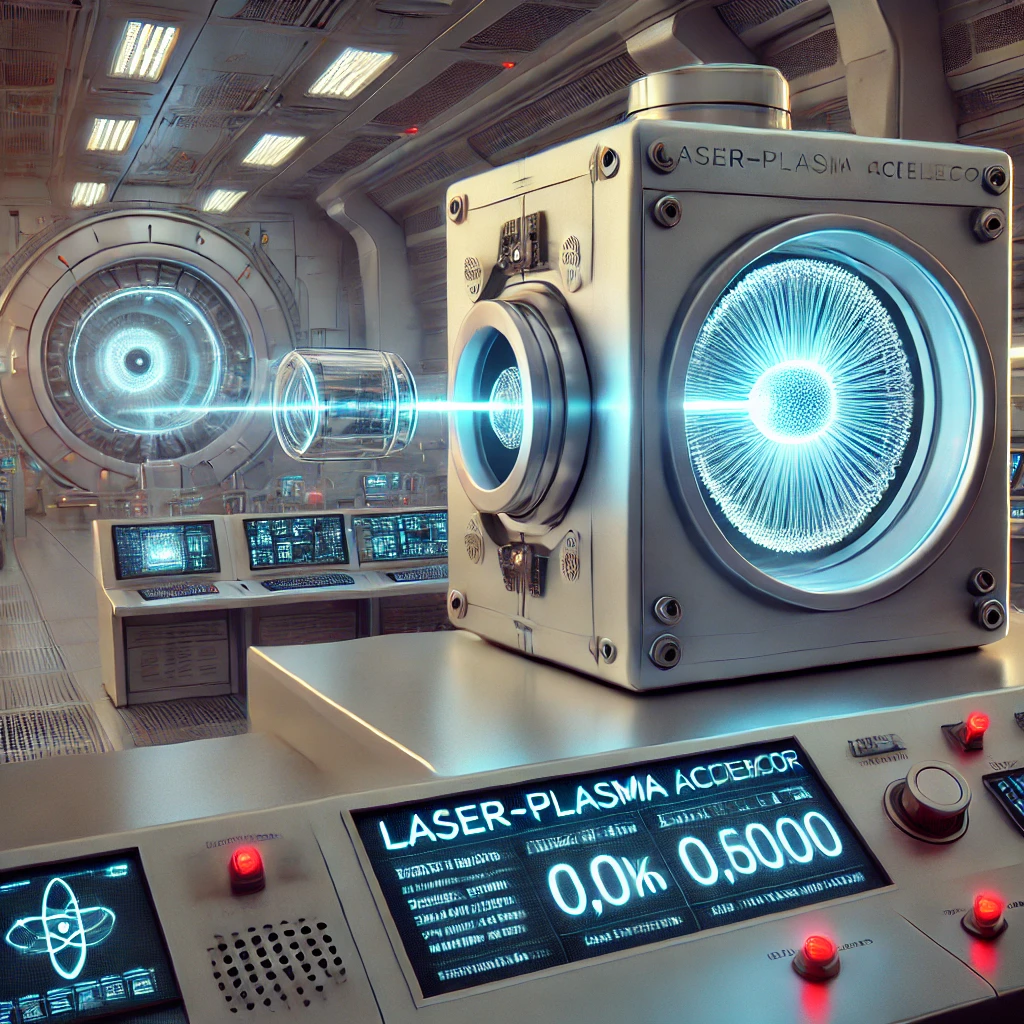- November 23, 2024
Tiny Laser-Plasma Accelerator: The Future of Particle Acceleration

Tiny Laser-Plasma Accelerator: The Future of Particle Acceleration
The Tiny Laser-Plasma Accelerator (LPA) represents a groundbreaking advancement in the field of particle physics. Unlike traditional particle accelerators, which are large and expensive, LPAs utilize ultra-high-intensity laser pulses to accelerate particles over tiny distances. This not only makes LPAs more compact but also far more efficient. In this article, we’ll delve into the working principle of LPAs, explore their advantages over traditional particle accelerators, and discuss their applications in medicine, science, and industry.

Introduction to Laser-Plasma Accelerators
A Laser-Plasma Accelerator (LPA) is a revolutionary technology that uses high-power lasers to accelerate particles to extremely high speeds within a plasma medium. Plasma, a state of matter made up of free electrons and ions, allows for much higher acceleration gradients than conventional accelerators. The ability to accelerate particles within a compact space offers significant benefits over traditional, large-scale accelerators like the Large Hadron Collider (LHC).
Working Principle of LPAs
The working principle of a Tiny Laser-Plasma Accelerator involves the interaction between a powerful laser pulse and a plasma medium. When a laser pulse enters the plasma, it generates a wakefield — much like the wake created behind a boat in water. This wakefield creates a strong electric field that can accelerate electrons (or other charged particles) to very high energies over short distances.
Unlike traditional accelerators, which rely on electromagnetic fields generated by large structures, LPAs use the natural electric fields in plasma to achieve particle acceleration at a fraction of the size.
Plasma Wakefield Generation and Acceleration
At the heart of the LPA’s functionality is plasma wakefield generation. When a laser pulse enters the plasma, it pushes the electrons ahead, creating a “bubble” or wakefield in its wake. Particles that are injected into this bubble can be accelerated by the strong electric fields created within it. This mechanism allows for much faster acceleration of particles, making LPAs extremely efficient.
Components of a Laser-Plasma Accelerator
A typical Laser-Plasma Accelerator consists of a few key components:
- High-Power Laser: This is the heart of the system, generating intense laser pulses to interact with the plasma.
- Plasma Source: Plasma is created either by using a gas jet or other methods to ionize the medium and enable the creation of wakefields.
- Accelerator Structure: The plasma medium acts as the structure that accelerates the particles.
- Diagnostics: Advanced tools are used to monitor the acceleration process and measure the energy and trajectory of the particles.
Advantages Over Traditional Particle Accelerators
There are several notable advantages of Tiny Laser-Plasma Accelerators over traditional particle accelerators:
- Compact Size: LPAs are far smaller than traditional accelerators. This is especially important for research facilities with limited space.
- Cost-Effective: Because they require less infrastructure, LPAs are much cheaper to build and operate compared to their traditional counterparts.
- Higher Acceleration Gradients: The electric fields in plasmas are much stronger than those in conventional accelerators, enabling much higher acceleration over short distances.
- Energy Efficiency: LPAs consume less power due to their small size and the natural efficiency of plasma-based acceleration.
Challenges in Laser-Plasma Acceleration
Despite their advantages, Tiny Laser-Plasma Accelerators still face several challenges:
- Stability: Maintaining stable acceleration in a plasma medium is difficult, as small fluctuations can significantly affect beam quality.
- Beam Quality: Achieving uniform particle energy and tight focusing of the beam remains a challenge.
- Laser Power: LPAs require extremely high-powered lasers, which present technological and energy consumption difficulties.
Applications in Medicine, Science, and Industry
The applications of Laser-Plasma Accelerators are vast and expanding:
- Medical Applications: LPAs can be used in cancer treatment, particularly in proton therapy. The high-energy particle beams generated by LPAs are ideal for targeting tumors with minimal damage to surrounding tissues.
- Scientific Research: LPAs are poised to revolutionize particle physics by making experiments more affordable and accessible. They can be used for fundamental research in high-energy physics and materials science.
- Industrial Use: LPAs can be applied in industrial radiography, offering a compact and efficient way to inspect materials for defects or to analyze complex structures at a microscopic level.
Future Developments and Potential of LPAs
The future of Tiny Laser-Plasma Accelerators is incredibly promising. Researchers are working to overcome the current challenges related to stability, beam quality, and laser power. With advancements in laser technology and plasma physics, LPAs have the potential to reshape industries and research across the globe.
Innovations in plasma wakefield acceleration may enable even more efficient particle beams, bringing the possibilities of compact accelerators closer to realization. The scalability of LPAs also opens the door to portable particle accelerators that could be used in fields like medical diagnostics, defense, and materials engineering.
Conclusion
In conclusion, the Tiny Laser-Plasma Accelerator represents the future of compact, cost-effective, and powerful particle acceleration. As technology advances, LPAs will likely transform numerous sectors, from medical therapies to cutting-edge physics research.